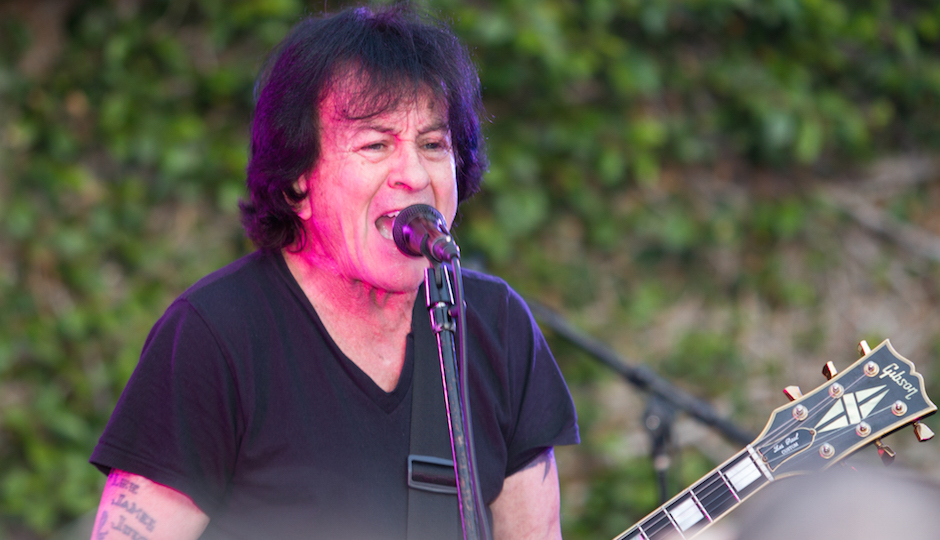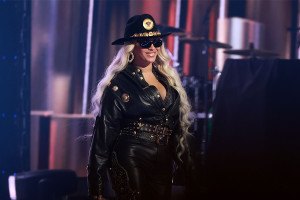The Life and Times of Philly Hardcore Pioneer Lee Ving
On the 1981 Halloween episode of Saturday Night Live, an extraordinary musical and sociological event happened: The punk band FEAR performed, and it was shocking for anyone who saw it live, and the footage would get buried by NBC executives for decades.
We may never see anything like it again in our lifetimes.
“They look very frightening,” said the SNL host, English actor Donald Pleasence, “but they’re really nice people … ladies and gentlemen, FEAR.”
“1234, 1234”, and then mayhem broke out, “Live from New York.” This was a time before the Internet, Netflix and cable TV. Network television used to be a really big deal. Ask your grandparents.
But first a little back story, from Philly.
——————————
Lee James Jude Capellaro was born in Philadelphia, at Germantown Hospital, and raised on the streets of Kensington in the 1950s — many years before hipsters started moving in, and he would move to Los Angeles to form his band FEAR.

Portrait of the artist as a young Kenzo
His early musical memories of the city were about as far away from punk rock as you can imagine: Mummers. “There were spontaneous Polish-American string bands,” he tells me by phone from his home in the San Fernando Valley. “They’d have unannounced parades on Allegheny Avenue to the pier at the Delaware River end, Pulaski Pier.”
Like many Philadelphia families, the Capalleros left the city for the leafy suburbs when the kids got older. Lee attended St. Luke’s Elementary School in Glenside and St. John of the Cross in Roslyn, before graduating from Abington High School. He went on to write the song Camarillo, based on an experience he had on a school field trip to the psychiatric ward at Norristown State Hospital. Capallero was an accomplished swimmer, but his first love was always music.
“I started singing in the womb. I was playing mandolin at 4 years old, taught by my mother. I found the mandolin in a closet. My mother had played in the high school band and taught me to read on it. I studied guitar at age 11 with Ann Brown in Roslyn, and later with Jim Hall and John Abercrombie, then later in L.A. with Ted Green. I’ve always been very serious about the music.”
Suburban life wasn’t exactly Leave it to Beaver. ”I was an abused kid, with a violent father who set me to living a life of fear at 6 months old. I went in the Army in 1966 and woke up every night screaming for 20 years after.”
Although he served stateside, this time period corresponded with the beginning of the Tet Offensive during the Viet Nam War. “A lot of my friends came home in body bags,” he adds.
When he got out of the army, he enrolled at Villanova, where he studied Sociology.
Back then, Philly had a thriving folk, blues and R&B scene, with acts such as Jim Croce, Hall & Oates, Bonnie Raitt and Todd Rundren’s Woody’s Truck Stop all cutting their teeth with national acts at the Main Point, the 2nd Fret and the original Electric Factory on Arch Street, almost every night of the week. Lee fell right into the scene and became the lead singer and harmonica player for the Sweet Stavin Chain Blues Band, playing with Danny Starobin (guitar), Eugene Busnar (bass), John Bussell (guitar) and frequently collaborating with Cheltenham High alum and future 15-time-Grammy-award-winning, Jazz Hall of Fame saxophonist, Michael Brecker.
“We played with everyone,” he says. “We played with Buddy Guy and Junior Wells. We played the Tunnel of Love at Willow Grove Park, hosted by ‘Roland,’ John Zacharly from Shock Theatre. We also played the Jerry Blavat TV show with B.B. King. Michael [Brecker] played with us when we opened for the Chambers Brothers and Eric Clapton, before Cream. We also opened for Cream’s farewell tour, at the sold out Spectrum in 1968, in the round. That was a great show.”
“We made some demo recordings for John Hammond Sr. at Atlantic Records in New York in 1967/68, which still may be accessible. Michael Brecker is on them, too. No one ever played Junior Walker or King Curtis as good as Michael.”
Commercial success for Sweet Stavin Chain (SSC) was elusive; the band eventually fizzled out after they released an album without Capallero and most of the original members.
“Big John had a great voice, but none of the musicians who played at SSC’s height are on that album. Just some local schlock Danny gathered up to make a record, but it’s not representative of the great band that contained Michael Brecker, me on lead vocals and harp, Eugene Busnar from New York on bass, Travis Rose from New York on drums and a whole host of great rhythm guitar players. We had also hired a jazz keyboard player from New York named Philip ‘Pot’ Namenworth.”
——————————

FEAR | Photo by Robert Seidemann
After SSC, Capallero moved to New York and studied voice and guitar before relocating a few years later to Los Angeles without much more than his Philly attitude. He didn’t immediately like the local music in the early L.A. punk scene, but he saw something, as he recently told Harper Simon:
“I thought the audience was great … people were responding in a way they weren’t responding to industry bands. If you would go see a Doobie Brothers show, it would be massively sold out, but people weren’t responding in any way like this. It was a close, and personal, one-on-one, punch-you-in-the-nose kind of audience participation. I knew that was the audience I wanted. I knew I could play better than the bands that were playing for them; I could write better than they could, I could sing better than they could, I could incite riots much better than they could, and if it came fucking down to it, I could fight better than they could, too. I was sold.”
Another person who was sold on the scene was documentary film director Penelope Spheeris, who went on to feature Lee Ving (as Capallero was now calling himself) and his band FEAR (featuring bassist/saxophonist Derf Scratch, Philo Cramer on guitar and Spit Stix on drums) in her iconic 1981 cult classic, The Decline of Western Civilization.
Ving starts the song “I Don’t Care About You,” with a nod to his hometown, belting out “I’m from South Street Philadelphia … ”
The film (recently re-released) and soundtrack featured gritty performances and poignant interviews with groundbreaking West Coast punk bands X, The Germs and Black Flag, as well as the fans. It is the quintessential punk time capsule for anyone curious about the birth of American hardcore, and FEAR were the underground stars. Soon after, the band released their full-length album, The Record. Recorded at Sound City Studios in Van Nuys, The Record is regarded as a punk masterpiece, and “I Don’t Care About You” was covered by Guns N Roses on their 1993 album of punk and hard-rock classics, The Spaghetti Incident?, and “Let’s Have a War” was covered on A Perfect Circle’s 2004 release eMOTIVe.
Songs by Ving and FEAR would go to feature on a pantheon of ‘80s influential punk movie soundtracks: Get Crazy, Repo Man, Class of ’84, and Bill & Ted’s Excellent Adventure.
“I almost broke my VCR watching Decline of Western Civilization so many times in the ‘80s, over and over and over again,” said singer/blogger/McGlinchey’s bartender/voice of reason Jo-Ann Rogan, whose band Thorazine toured with FEAR in the ‘90s.
“That tour was a dream come true. FEAR is the band that made me want to start my own punk band, and Lee is the nicest guy in the world, contrary to his public image.”
——————————

Capellaro with John Belushi | Photo by Barbara Biro
Another person sold on FEAR was actor John Belushi, who befriended and championed the band, becoming one of their first and most ardent supporters. He got them booked as the musical guest on SNL. The episode skewed very punk rock.
The set, featuring performance of “New York’s Alright If You Like Saxophones,” “Let’s Have a War,” and “Beef Bologna” turned into the first network-televised full-on mosh pit, with members of Minor Threat, Cro-mags, The Meatmen and Negative Approach in the audience. They rushed the stage, and the New York Post reported $200,000 worth of damage to the studio under the headline “FEAR Riot Leave Saturday Night Glad to Be Alive.” The network execs were horrified, but history had been made. The punk flag was planted into middle America’s living room.
Unfortunately, Belushi tragically died a few months after that show. The band had lost their champion, and the record labels and industry people were leery of punk’s chaotic and dangerous energy. For the band, and for punk, there wasn’t going to be another mainstream break, at least until Nirvana and Green Day 10 years later. FEAR recorded several other albums with a rotating cast of band members (including, for a short time, a pre-Red Hot Chili Peppers Flea on bass,) but none of the albums had the impact of The Record.
There had long been rumors that before his death, John Belushi had recorded a single with FEAR, produced by legendary Stax session man (and Blues Brother) Steve Cropper. It was meant to be on the soundtrack to Belushi’s 1981 film Neighbors, but the movie studio rejected it outright. After his death, the song got lost in the shuffle, but with the help of Belushi’s widow, Judith, the tapes have recently been recovered, re-mastered and re-mixed by Ving at Dave Grohl’s 606 studios in Los Angeles, and the music will finally see the light of day this Halloween. In addition to the digital release, there will also be a special seven-inch vinyl pressing with vocals from both Ving and Belushi.
As Ving told Rolling Stone, Belushi was reluctant to do the vocals:
“I kept arguing with John, ‘I wrote the lyrics for you to sing.’ I was quite militant on the punk rock issue of being punk-correct, in that I wasn’t looking forward to singing lyrics that I had written for someone else to sing that were based on a movie that didn’t touch my life. The lyrics weren’t authentic enough for me to sing them. We went back and forth, and eventually John says, ‘OK, OK, I’ll sing it.’ John, being such a good mimic, sings it, and you can tell it’s not me.”
——————————

Capellaro today | Photo by Waxman Photography
And now there is a movement to induct Lee Ving into the Philadelphia Music Alliance Walk of Fame, alongside Mario Lanza and Chubby Checker, and his friend Michael Brecker, and to have him inducted by Philly expat and Walk of Famer Joan Jett.
“He abso-fucking-lutely belongs on the Walk of Fame,” says Rogan. “Punk is sorely unrepresented in the city’s history. I’d love to be on Broad Street when it happens.”
“Philly Walk of Fame would be such an honor. I have always loved all the Philly music from Mario’s “Vesti La Giubba” from Pagliacci, and Chubby’s ‘Let’s Do the Twist,’ which I heard the week it was released. I also remember watching American Bandstand before it was hosted by Grady and Hurst. I just met Joan [Jett] last year while I toured as a special guest with the Foo Fighters.”
“By the way, most of what you read about me on the Internet is factually incorrect. It was put up by someone years ago and I haven’t gotten around to fixing it.”
“Philly has a certain edge to it that most cities don’t have. It’s not a hippy town, and I love that. When I was a kid, my parents did things I would never do. I mean, I could ride my tricycle down Clearfield Street at all hours and they’d have no idea where I was. That’s crazy.”
For all his expressed love for the city, he doesn’t get back often, admitting “Only for family reasons, really, and the band has only played the area a few times.”
But maybe that will change soon. There are plans in the works for a new tour, and when contacted about the possibility of a Philly homecoming show, Sean Agnew from R5 Productions replied, “Yes, I’m interested.”
For tour updates, check FEARLeeVing.com.
Tim McCloskey lives in Juniata Park, the “Beverly Hills of Kensington.” He previously wrote about Jimmy Fallon and St. Patrick’s Day.


